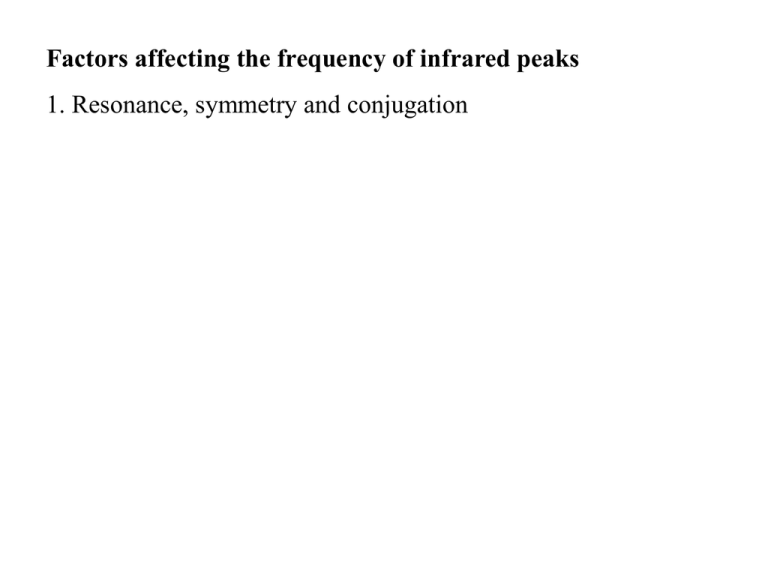IR Lecture 4
advertisement

Factors affecting the frequency of infrared peaks 1. Resonance, symmetry and conjugation Effect of resonance, symmetry and conjugation on infrared frequencies O O+ + N N O - O O- O C C O - O + NR2 NR2 C C O - O What about the effect of conjugation? + O Do the facts support this interaction? O- O- O C C O O - Carbonyl frequency: 1720-1680 (acid) 1700 cm-1 Ether frequency = 1000 to 1400 cm-1 1200 cm-1 Average of the two fundamentals = 1450 cm-1 1560 cm-1 O- O C C O O - 1410 cm-1 (1560+ 1410)/2 = 1485 cm-1 Resonance 100 % Transmittance 80 60 40 20 1550 1400 0 4000 3500 3000 2500 2000 1500 -1 Wavenumbers, cm Figure IR-42. Sodium benzoate, KBr pellet: 1000 500 Sodium benzoate: (1550, 1400 cm-1 ); Average : 1475 cm-1 Sodium acetate: (1560, 1410 cm-1 ); Average : 1485 cm-1 O R O- NR2 R How important is resonance in amides? NR2+ O R O- NR2 R NR2+ How important is resonance in amides? O In CH3 H N CH3 the barrier to rotation of the two CH3 groups is approximately 18 kcal/mol (A C-C bond is worth about 60 kcal/mol) Table 4. The effect of conjugation on carbonyl frequencies. Non-conjugated Compound Frequency Conjugated -1 Compound cm Frequency -1 cm Frequency -1 cm butanal 1725 2-butenal 1691 benzaldehyde 1702 2-butanone 1717 methyl vinyl ketone 1700, 1681 acetophenone 1685 propanoic acid 1715 propenoic acid 1702 benzoic acid 1688 ethyl propionate 1740 ethyl acrylate 1727 ethyl benzoate 1718 butanoic anhydride 1819, 1750 2-butenoic anhydride 1782, 1722 benzoic anhydride 1786, 1726 cis-cyclohexane1,2-dicarboxylic anhydride 1857, 1786 1-cyclohexene1,2-dicarboxylic anhydride 1844, 1767 phthalic anhydride 1852, 1762 Other effects of conjugation on carbonyl frequencies 100 % Transmittance 80 60 40 20 0 4000 3500 3000 2500 2000 1500 1000 500 -1 Wavenumbers, cm Figure IR-45. Ethyl vinyl ketone, neat liquid: CH3CH2COCH=CH2 100 % Transmittance 80 60 40 20 0 4000 3500 3000 2500 2000 1500 1000 500 -1 Wavenumbers, cm Figure IR-44. 3-Nonen-2-one, 95%; neat liquid, thin film: O Why the extra carbonyl peaks? CH3 CH=CH(CH2)4CH3 O O Factors affecting the intensities : Extent of interaction (dipole moment change) Concentration of each conformer + O O- Effects of conjugation on double bonds What’s this? Factors affecting the frequency of infrared peaks 1. Resonance and conjugation 2. Ring strain: A: on carbonyl frequencies 1720 cm-1 1750 cm-1 1775 cm-1 cyclopropanone 1800 cm-1 Table. The Effect of Ring Strain on the Carbonyl Frequencies of Some Cyclic Molecules Ring Size ketone: cm-1 lactone: cm-1 lactam: cm-1 3 cyclopropanone: 1800 4 cyclobutanone: 1775 b-propiolactone: 1840 5 cyclopentanone: 1751 g-butyrolactone: 1750 g-butyrolactam: 1690 6 cyclohexanone: 1715 d-valerolactone: 1740 d-valerolactam: 1668 7 cycloheptanone: 1702 e-caprolactone: 1730 e-caprolactam: 1658 Factors affecting the frequency of infrared peaks 1. Resonance and conjugation 2. Ring strain: A: on carbonyl frequencies B. on C-H stretching frequencies What is the hybridization of a C-H bond in cyclopropane? What is the hybridization of a C-H bond in cyclopropane? Based on acidity, C-H bonds are somewhere between sp2 and sp3 This is also confirmed by 13C-H coupling constant as we will see CH2OH CH2OH Factors affecting the frequency of infrared peaks 1. Resonance and conjugation 2. Ring strain: A: on carbonyl frequencies B. on C-H stretching frequencies 3. Halogens A: on carbonyl frequencies B. on C-H stretching frequencies 3011 1760 Factors affecting the frequency of infrared peaks 1. Resonance and conjugation 2. Ring strain: A: on carbonyl frequencies B. on C-H stretching frequencies 3. Halogens A: on carbonyl frequencies B. on C-H stretching frequencies 4. Chirality Why the big differences between D-serine and DL-serine? d l d d l Some Examples of Conglomerates Asparagine Threonine Glutamic Acid Serine Anhydride N-Acetylproline Factors affecting the frequency of infrared peaks 1. Resonance and conjugation 2. Ring strain: A: on carbonyl frequencies B. on C-H stretching frequencies 3. Halogens A: on carbonyl frequencies B. on C-H stretching frequencies 4. Chirality 5. Phase: solid, liquid and gas (fundamentals in the gas phase are shifted to higher frequencies) ie. solvent or solute interactions lead to weakening of force constants; effects of H-bonding. Effects of H-bonding 120 Vapor phase spectrum(135 °C) % Transmittance 100 80 liquid film 60 40 20 0 4000 3500 3000 2500 2000 1500 1000 Wavenumbers, cm-1 Figure IR-25. The liquid and vapor spectra of phenol. OH Gas Phase FT-IR spectrum of 2,4-pentanedione, Aldrich Chemical Co. Effect of Phase Liquid film Effect of Phase CCl4 solution Effect of Phase KBr Effects of H-bonding 2000 1000 cm-1 FT IR ATR: attenuated total reflectance; when a beam of electromagnetic radiation is reflected off an object, it actually penetrates of the order of one wavelength. In IR, this is of the order of microns which is sufficient to obtain a spectrum of the material provided it is polydispersed. The depth of penetration is wavelength dependent, it is therefore necessary to compensate for this dependency. 11 10 9 Single Beam 8 7 6 5 4 3 2 4000 3000 2000 W avenumbers (cm-1) 1000 Infrared spectrum of ATR and of the background CO2 and H2O vapor.




